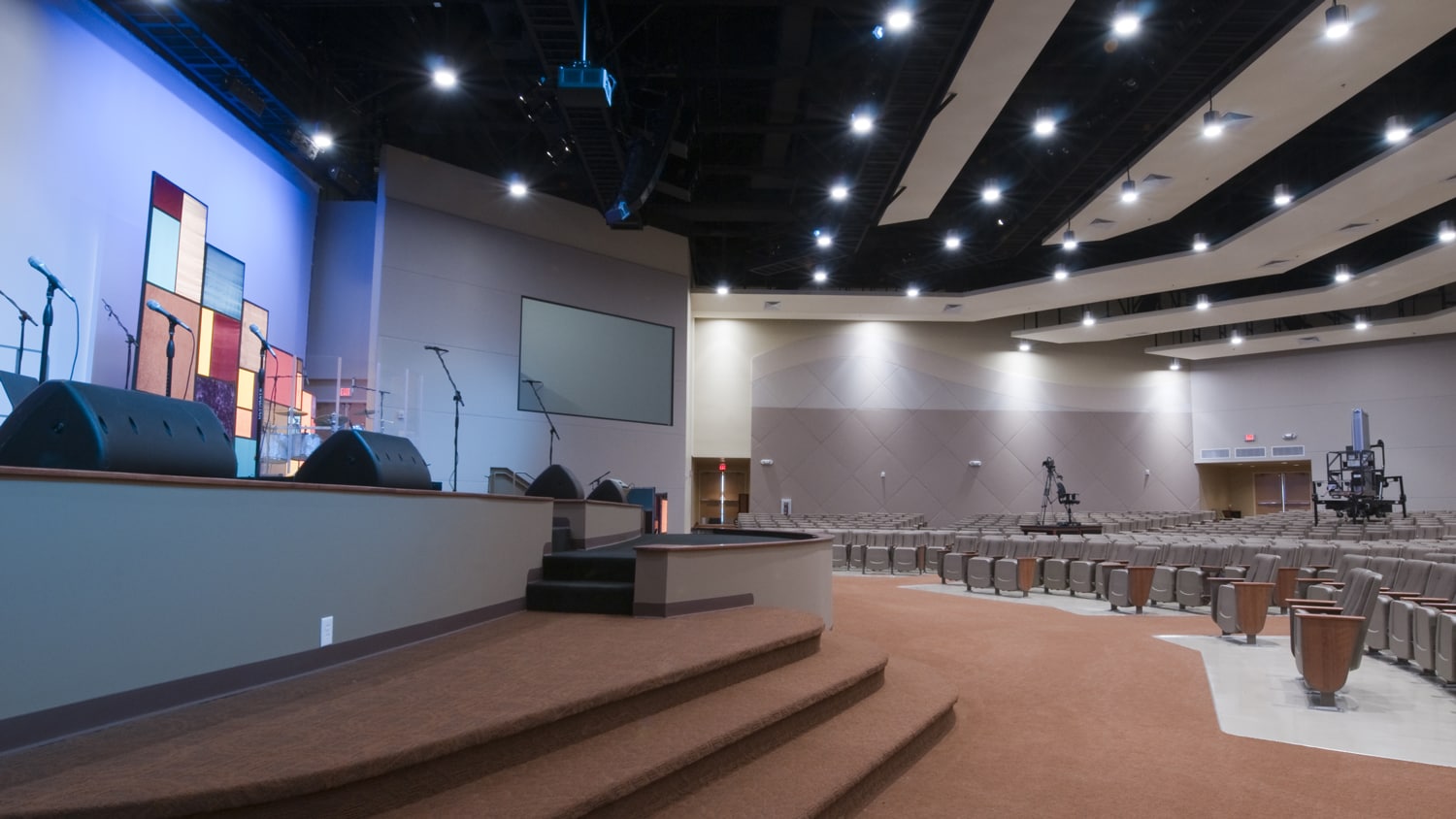The main objective of a house of worship sound system is to ensure the message is clearly understood. However, for many houses of worship, this can be a challenge, as sanctuaries tend to be reverberant spaces where things “just don’t sound right,” particularly when amplified through a PA system.
Part of this is because the beauty of the architecture is often of major importance when designing sanctuaries. The materials, finishings, room shapes and furnishings that bring this beauty also bring echo and noise that make it harder to hear clearly. Additionally, older sanctuaries (or those built in a traditional style) are typically designed to help sound carry without amplification. When you add in a PA system, this building design can work against the sound system, resulting in an environment where it’s difficult to hear what’s being said.
Acoustic treatments are a great way to improve clarity and intelligibility within the sanctuary. While a well-designed sound system with properly positioned speakers can help address some of these issues, they can only do so much within a reverberant space. By working with the experts at Guitar Center Professional, you can add proper acoustic treatment to your house of worship to make it easier to hear your message, increasing the impact of your service without ruining the visual aesthetic of your space.
Why Acoustic Treatment is Important
Adding acoustic panels to a worship space can really improve how good your PA system sounds. This is because many sanctuary audio problems are actually acoustics problems. To understand why this is, it’s important to understand how sound works within a space.
It’s sometimes easy to forget that it takes time for sound to travel across a room. Even with a well-designed PA system, some of the sound will travel directly from the loudspeaker to the listener, while other sounds will travel from the loudspeaker to a reflective surface (wall, floor, etc.) and then bounce back to the listener.
It takes additional time for the sound to travel along that indirect route, meaning the timing of the reflected sound will be slightly delayed from the direct sound. Because the listener will hear both the direct sound and the delayed reflection, this results in a discrete echo longer than 40ms that makes it harder to understand what is being communicated. Additionally, surfaces respond to different sound frequencies in different ways. Certain frequencies could be reflected back, while other frequencies are absorbed. This can distort the sound of the audio mix, making things sound “boomy,” “tinny,” etc., despite how the sound engineer has adjusted the mix.
Adding acoustic panels to your house of worship can address these issues, both for music and for spoken word. Controlling reflections helps the intelligibility of the vocals and instrumentation, particularly for choirs, orchestras and organs, which are naturally loud within the space. Additionally, because it reduces reflections, it can increase intelligibility for presenters during the service, particularly for those in the audience who are hard of hearing. With well-placed acoustic treatment in the space, houses of worship can improve parishioner engagement and enhance the overall experience.
Considerations for Acoustic Treatments
When you’re looking to add acoustic treatments to your sanctuary, call your Guitar Center Professional account manager and a design engineer will consider the following things.
Size of the Sanctuary
The first thing you will need to look at is the size of your space. Larger rooms typically require more treatment, because sound needs more time to travel to reflective surfaces and then back to the listener. Long, wide or high spaces can also be problematic, even if the overall size is smaller. You’ll need to capture accurate dimensions for your space when you begin your project, including the length, width and height of the space.
Shape of the Sanctuary
In addition to the actual size of the space, the shape of your sanctuary will also have a big effect on the type of acoustic treatment you need. For example, corners, particularly 90-degree angles, will reinforce low frequencies, contributing boosts and dips of the sound from the speakers. Bass traps are often installed to correct this. Additionally, parallel surfaces (walls, ceiling/floor, etc.) can produce auditory anomalies called “room modes” that cause sounds to spike or dip at certain frequencies depending on the dimensions of the room. These modes can be accounted for using room mode calculators, which our engineers will use to determine the proper placement for acoustic panels. Odd angles, balconies and unusual shapes are common in sanctuaries and can be problem spots for room acoustics, and we will take them into account when beginning your project.
Sanctuary Surfaces and Contents
Don’t forget that the materials in the room are just as important as the shape of the room. Rooms with highly reflective surfaces, such as stained glass, or tiled or wood flooring will increase your need for acoustic treatment. This is because softer materials, such as carpets and drapes, absorb sound at particular frequencies more readily than harder materials, such as wood, glass and metal. This is also true for the contents of the space, where a padded chair or curtained window treatment will be less reflective than hardwood pews or polished metal candleholders.
That said, these materials won’t absorb sound consistently at all frequencies. Sometimes surfaces such as brick or concrete diffuse sound at higher frequencies, while drywall might absorb lower frequencies. As we mentioned before, this will change the sound of the mix and make it more difficult to achieve the sound you want. Proper acoustic treatment is more effective over a wider range of frequencies, resulting in a better overall sound.
That being said, it’s important to consider the visual aesthetic of your sanctuary when applying acoustic treatment as well. While covering reflective surfaces with acoustic panels may improve the sound, it can impact the aesthetic of the sanctuary and detract from the overall worship experience.
Speaker Positioning and Stage Noise
One of the things we mentioned earlier is that having a properly designed sound system can help address acoustic issues in your space. This is because the role of a good sound system design is to ensure you have consistent sound at a suitable sound pressure level (SPL) across all of the seated areas, while sending as little sound as possible toward reflective surfaces (floors, ceilings, balconies, etc.). As you begin considering your house of worship acoustics, it’s a good idea to also look at your speaker placement and audio system configuration as well. A minor adjustment to a speaker position or amplifier level can have a big impact on the amount of reflections in your space.
Additionally, you should also look at your backline and determine if there are ways to reduce stage noise. Acoustic drums, for example, can cause a lot of noise, and proper dampeners or drum shields can help reduce it. Similarly, removing speakers from the stage, whether it’s a guitar amplifier or a floor monitor, can help reduce ambient noise. Houses of worship using electric guitars might consider a dedicated amp room, which can eliminate sound from the stage while allowing the amplifier to be turned up louder for better tone. For monitoring, in-ear monitors (IEMs) can provide better sound isolation and more personalized monitoring than a floor wedge, along with less noise on the stage. To learn more about how addressing your backline can reduce the sound coming from the stage, check out our article “Essential Backline Equipment for Houses of Worship.”
How to Begin Acoustic Treatment
Acoustic treatment can be the most cost-effective way to improve the sound and intelligibility of the PA system in your house of worship, but it’s important that the acoustic treatment be properly designed to address the needs of your venue. Thankfully, the experts at Guitar Center Professional are available for a free consultation to help you determine what’s right for your space.
Once you have a plan in place, your house of worship can probably install the acoustic panel itself the acoustic panels themselves. Installation is typically straightforward, and there are no electronics involved, so a general contractor or church repair person can typically get the job done just fine.
It’s also ok to add acoustic treatment over time. Many houses of worship will begin by adding acoustic panels to the most important areas and see how it affects the sound in the space. This helps spread out the financial impact of the treatment and allows you to make adjustments and improvements over time until the issues are resolved in the space.
When beginning acoustic treatment, it’s typically best to start with the rear wall or front balcony. These are often the source of the loudest reflections in the space. By addressing these areas first, you not only fix the biggest issues in the space, but you also make it easier to identify other problem areas for potential treatment.
In addition to wall and ceiling-mounted treatments, there are also specialized products to help address certain problem areas. For example, buildings with exposed ductwork might consider products that reduce duct noise. Large, vaulted ceilings can also benefit from ceiling clouds that can be suspended from above and address early reflections.
When you are looking at acoustic panels, a common size to get is a 2' x 4' panel. Typical depth for the panels is 1" or 2", depending on your needs. Good products to look at include the Primacoustic Broadway Series and the Auralex ProPanel Series.
In Summary
In this blog, we’ve looked at how good acoustic treatment can reduce reflections, improve clarity and intelligibility, and increase the performance of your house of worship sound system. We also looked at some of the important considerations for acoustic treatment, including the size and shape of your space, the surfaces and contents, and the impact of your sound system and backline. Finally, we discussed how to approach treating your space and looked at some key products.
If you need help addressing sound issues in your house of worship, remember to reach out to Guitar Center Professional for a free consultation.




